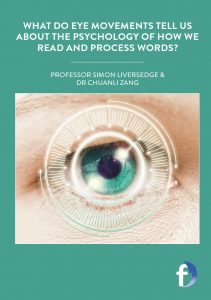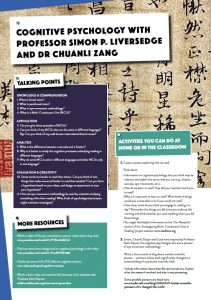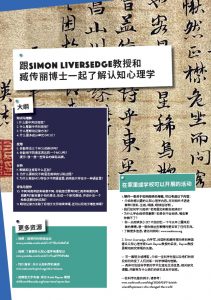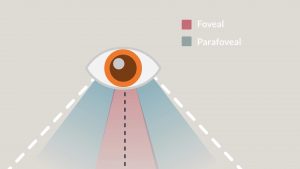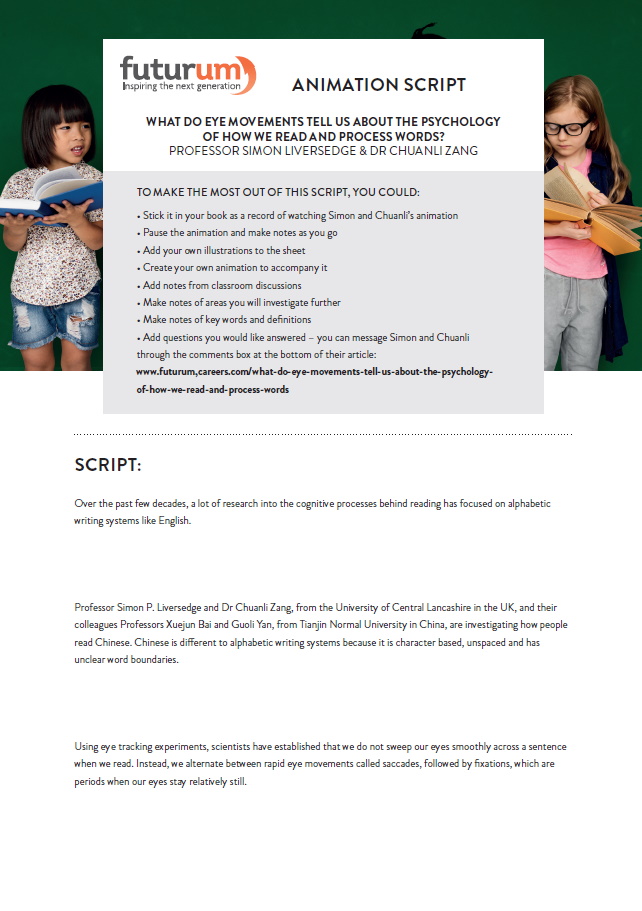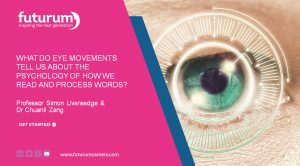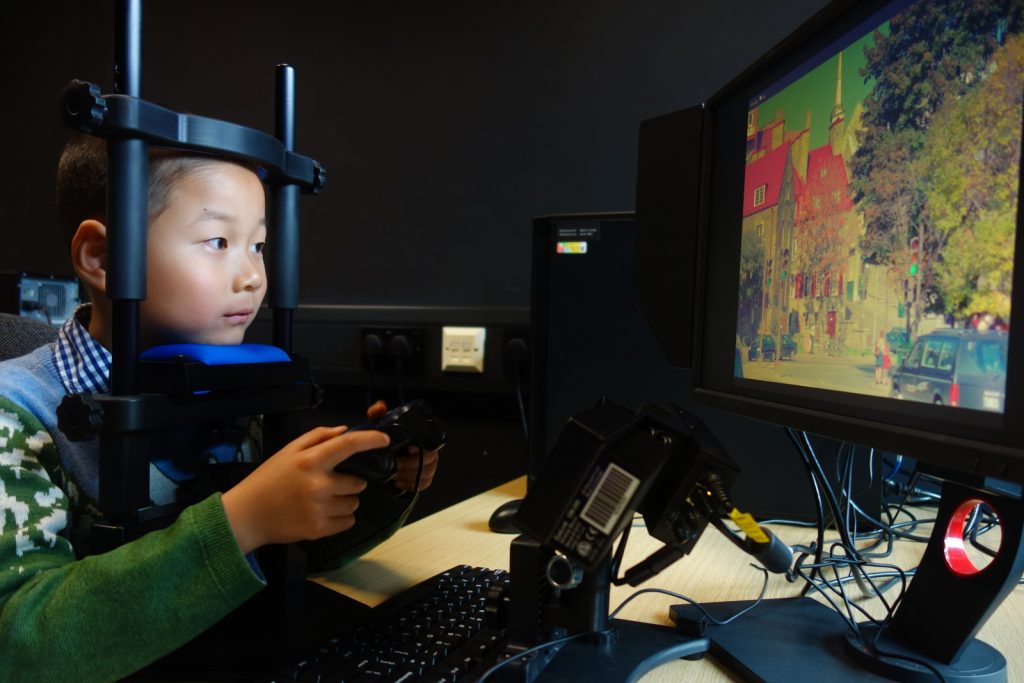What do eye movements tell us about the psychology of how we read and process words?
Decades of research has improved our understanding of the cognitive processes that occur when people read. However, there is conflicting evidence about what happens psychologically when we read and process words. Professors Simon P. Liversedge, Xuejun Bai, Guoli Yan and Dr Chuanli Zang, at the University of Central Lancashire in the UK and Tianjin Normal University in China, use eye movement methodology to identify how people read and understand Chinese writing. They have developed the multi-constituent unit hypothesis, and hope to resolve some of the scientific debates surrounding the cognitive processes behind reading
TALK LIKE A COGNITIVE PSYCHOLOGIST
COGNITIVE – related to mental processes such as thinking, understanding, learning, and remembering
LINGUISTIC – related to language
EYE MOVEMENT METHODOLOGY – the process of measuring the movements of the eyes, usually using an eye tracking device
FOVEAL VISION – vision within a central part of the eye called the fovea, where the eye is best able to distinguish shapes and details
PARAFOVEAL VISION – vision within the parafoveal region of the eye which surrounds the fovea, where the eye’s ability to distinguish shapes and details is comparatively reduced
HYPOTHESIS – a proposed explanation for something that has not yet been fully explained, which can be tested by scientific methods
MILLISECOND (MS) – one thousandth (0.001) of a second
SACCADE – a rapid rotation of the eyeballs
Over the past few decades, research into the cognitive processes linked to reading has improved the way we teach children to read. However, there are still unresolved scientific debates about how people process text when they read.
A lot of previous research has focused on alphabetic writing systems like English. Chinese is different to alphabetic writing systems because it is character based, unspaced and has unclear word boundaries (see box on THE CHINESE WRITING SYSTEM). Studying written Chinese, therefore, enables cognitive psychologists to investigate questions that are impossible to research in other writing systems. Professors Simon P. Liversedge, Xuejun Bai, Guoli Yan and Dr Chuanli Zang, from the University of Central Lancashire and Tianjin Normal University, use eye movement methodology to understand reading of Chinese. Based on these experiments, they have developed a new hypothesis called the Multi-Constituent Unit hypothesis, which may explain some of the gaps in our understanding of the cognitive psychology of reading.
HOW DO OUR EYES MOVE WHEN WE READ?
“Patterns of eye movements reflect moment to moment cognitive processes that occur as a reader understands text,” Chuanli explains. Using eye tracking experiments, scientists have established that we do not sweep our eyes smoothly across a sentence when we read. Instead, we alternate between rapid eye movements called saccades which last 10-50 ms followed by fixations – periods of around 200-250 ms when our eyes stay relatively still – to extract visual information about each of the words we are reading. When words are in foveal vision, very detailed information is encoded, which allows the words to be fully processed and identified. Words in the parafovea are partially processed. Saccades bring the words in the parafovea into foveal vision. Readers do not fixate on all words – they sometimes skip them, making a saccade over them.
WHAT SCIENTIFIC QUESTIONS ABOUT EYE MOVEMENTS ARE STILL UNANSWERED?
There is still debate about how words are processed when people read. Simon says that a key scientific question is: “are multiple words lexically identified at the same time, or are they identified one by one?” This debate has, so far, been informed mainly by studies investigating reading of alphabetic writing systems such as English. Understanding how people read non-alphabetic, unspaced writing systems like Chinese, allows us to investigate an important gap in current understanding. However, as words are not clearly segmented in Chinese, this challenges scientists to consider whether research questions about the order in which words are read are applicable to this writing system, and which questions we need to ask to understand cognitive processes related to reading.
HOW CAN EXPERIMENTS HELP US TO UNDERSTAND READING CHINESE?
The team uses an eye tracker, a device that measures people’s eye movements while they read. The eye tracker is positioned in front of a research participant who sits and reads sentences from a computer screen. The tracker records the reader’s eye position (the particular letter or character the reader is fixating) every millisecond to give a very precise indication of where the reader is looking.
Data are recorded on eye position, the duration of fixations, the time readers spend processing a word, how often readers skip a word and whether readers make right-to-left movements to re-read portions of sentences. These factors indicate which parts of the text are more difficult to read. The team then does statistical analyses of the data.
WHAT IS A MULTI-CONSTITUENT UNIT?
The Multi-Constituent Unit (MCU) hypothesis was developed by Simon, Chuanli and their colleagues based on their eye movement experiments. It may explain why experiments suggest that when people read, on some occasions, multiple words are identified at the same time, and, on other occasions, words are identified one by one. “The idea is that some frequently occurring linguistic units are made up of more than a single word. For example, spaced compound words like ‘teddy bear’, and common phrases like ‘salt and pepper’,” explains Chuanli. These MCUs may be processed as if they were single words, which could result in more than one word being processed at the same time (i.e. ‘teddy’ and ‘bear’ may be processed at the same time, rather than one after the other, because they are identified as a single word).
The team has carried out more than ten experiments supporting their MCU hypothesis. It has shown that frequently used Chinese phrases, expressions, famous people’s names, place names, product names and popular phrases (many from social media), are often processed as MCUs during reading.
WHAT IS THE WIDER IMPORTANCE OF THIS RESEARCH?
This research expands scientific knowledge of cognitive processes related to reading, contributing to understanding in psychology, linguistics and education, with practical implications for society. For example, understanding how MCUs are learned and segmented can help children and adults learning to read Chinese. Simon says, “Ultimately, our work has the potential to influence educational best practice related to teaching, literacy development and support for those with learning difficulties.”

PROFESSOR SIMON P. LIVERSEDGE
DR CHUANLI ZANG
School of Psychology and Computer Science, University of Central Lancashire, UK
PROFESSOR XUEJUN BAI
PROFESSOR GUOLI YAN
Faculty of Psychology, Tianjin Normal University, China
FIELD OF RESEARCH: Cognitive Psychology
RESEARCH PROJECT: Investigating the Multi-Constituent Unit (MCU) hypothesis – seeking to understand cognitive processes behind reading to help resolve key scientific debates and inform better educational practices
FUNDER: Economic and Social Research Council Grant (ES/R003386/1)
THE CHINESE WRITING SYSTEM
• Chinese writing is based on characters rather than an alphabet.
• Each character consists of strokes with simple features like dots, lines and curves which are put together to form sentences e.g. 十种方法让学习变得简单有趣 means ten ways to make learning easy and enjoyable.
• Chinese words are one, two, three or more characters long.
• There are no spaces between characters and words – the writing system is described as ‘unspaced’ – so Chinese readers must make decisions about where word boundaries lie as they read a sentence. This is a cognitive process called ‘word segmentation’.
• Word segmentation is not always clear, and it is quite common for Chinese readers to disagree about where the word boundaries in a sentence lie.
• The distinction between words and phrases can also be unclear. For example 简单有趣 means easy and enjoyable – a phrase in English, but this is sometimes segmented as a word by Chinese readers. In fact, the Chinese did not have a term for ‘word’ until the beginning of the 20th century.
• Different segmentations sometimes result in confusing interpretations, for instance when we segment the sentence as follows: 武汉市|长江大桥|欢迎|您 it means Wuhan city|Yangtze river bridge|welcomes|you; but if we segment it as follows: 武汉|市长|江大桥|欢迎|您 it means Wuhan city|major|Jiangdaqiao|welcomes|you.
Reference
https://doi.org/10.33424/FUTURUM345
ABOUT COGNITIVE PSYCHOLOGY
Cognitive psychology is the study of mental processes related to how people perceive, recognise, read, learn, remember and think about information. To understand these processes, cognitive psychologists use a range of scientific research methods: proposing research questions, generating hypotheses, collecting data, analysing data, developing theory, and sometimes applying the implications of research findings to practical settings.
Cognitive psychologists, like other academics, often teach university students about what they have discovered and why it is important. This motivates students to think about pursuing a research career of their own and carrying out future experiments that will further develop scientific understanding. Simon says, “Having an opportunity to teach and inspire students is very rewarding.”
IMPACTING SOCIETY
Understanding mental processes can help us improve the way society functions in relation to those processes. For example, scientific investigations of reading over the past few decades have led to the development of evidence-based educational policy to improve teaching. “It is very rewarding to know that the research we undertake directly impacts how children in schools are taught to read,” says Chuanli.
COLLABORATIONS
Teamwork between scientists in the UK and China enables research on cross-linguistic and cross-cultural issues. Simon has worked with Xuejun, Guoli and Chuanli, as well as other colleagues at Tianjin Normal University (TNU) for over 15 years. He says, “Without this collaborative relationship, our research, which informs our understanding of reading and other cognitive processes, would not have been possible.”
The relationship has had other benefits, such as enabling exchanges so that students and staff can experience working in a research lab in another country. “International collaborations lead to cultural exchange and friendships that are long lasting and important,” says Chuanli.
LOOKING AHEAD
The team thinks that eye movement methodology will continue to be an important feature of cognitive psychology in future. Another developing area of research involves combining this methodology with real-time measurements of brain activity. Using these techniques at the same time will enable scientists to better understand the links between brain activity and the cognitive processes occurring while visual tasks, like reading, are being performed.
Although there has been a lot of research to investigate reading in English, Simon points out that there has been comparatively less work to investigate how people read other writing systems. This is particularly true for non-alphabetic writing systems like Chinese, so there is a need for more research exploring reading in these writing systems.
EXPLORE CAREERS IN COGNITIVE PSYCHOLOGY
• University outreach programmes can help you to learn more about life as a cognitive psychologist. For example, the University of Central Lancashire (UCLan) offers school visits to the cognitive psychology labs, and there will be psychology information sessions coming to UCLan’s Young Scientist Centre.
• Simon, Chuanli and colleagues also attend the annual Lancashire Science Festival, where they give talks explaining fascinating psychological experiments.
• The British Psychology Society and the Experimental Psychology Society provide useful information about cognitive psychology and related career paths.
• In the UK, the average salary of a psychologist ranges from about £30,000 to £90,000 per year.
PATHWAY FROM SCHOOL TO COGNITIVE PSYCHOLOGY
• Generally, to be a cognitive psychologist, you will need an undergraduate degree in psychology. After this, it is also usually necessary to obtain a master’s degree and PhD.
• To become a chartered psychologist, you need to take a course accredited by the British Psychology Society.
• You must study maths or at least one science subject (such as biology, physics or chemistry) at school to be eligible for
many psychology undergraduate degrees. However, entry requirements vary depending on the university.
• Simon also advises that because scientists must publish their findings, solid English skills are very important.
HOW DID SIMON AND CHUANLI BECOME COGNITIVE PSYCHOLOGISTS?
Both Simon and Chuanli were interested in science and nature when they were younger. Another similarity is that they were both intrigued by what humans do mentally in their daily lives.
Simon: “I worked hard at school, then did my A-levels before becoming an undergraduate student at the University of Dundee. There, I conducted an eye movement experiment to investigate reading for my dissertation and through this became interested in this area. I was fortunate to secure competitive funding to support my research for my PhD and then went on to work for several years as a Postdoctoral Research Fellow in Nottingham University. After this, I took a position as a lecturer at Durham University before moving to be a professor at the University of Southampton. During this time, I developed links with colleagues in China, working closely with Xuejun and Guoli.”
Chuanli: “I also worked very hard at school! I attended Yantai Normal University (now Ludong University) where I studied for my degree in psychology. I moved to Tianjin Normal University to take my master’s degree and PhD, where I was supervised by Xuejun. During the PhD, I decided to visit the UK to work with Simon and applied for a China Scholarship Council award to allow me to do so. I first met and started working with Simon during my first visit to the UK. Simon and I then China wrote a successful grant application which allowed us to undertake the research project investigating Chinese reading, and now I work with him at the University of Central Lancashire as a research fellow. We both still work closely with Xuejun and Guoli in Tianjin, and we try to visit China on work trips, when we can.”
As they progressed through education and research, Simon and Chuanli were both inspired by many great researchers working in cognitive psychology. In particular, Professor Keith Rayner – a pioneer in making eye movement methodology, a major tool for studying cognitive processes – inspired them to pursue their research.
Simon and Chuanli say that it is through perseverance, ambition and hard work that they have become successful scientists. They are very proud of their work, especially their international collaborative research carried out between China and the UK.
SIMON AND CHUANLI’S TOP TIPS
“To follow in our footsteps, there are two key ingredients for (100%) success:
01 Maintain strong motivation to achieve your goals (20%)
02 Work very hard (80%)!”
Do you have a question for Simon or Chuanli?
Write it in the comments box below and Simon or Chuanli will get back to you. (Remember, researchers are very busy people, so you may have to wait a few days.)

